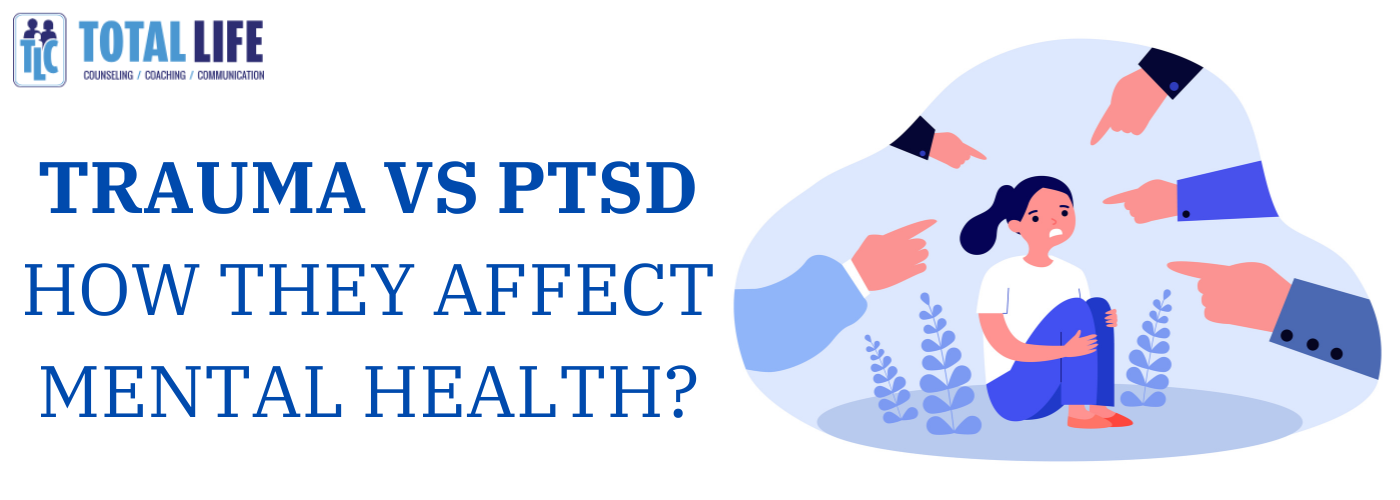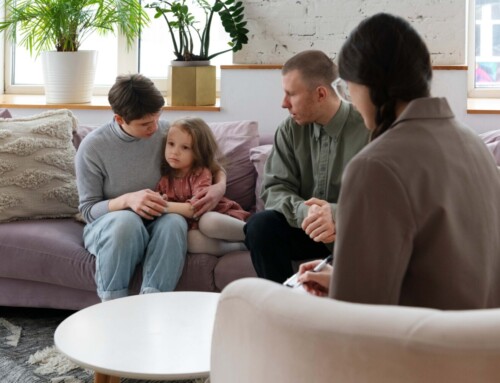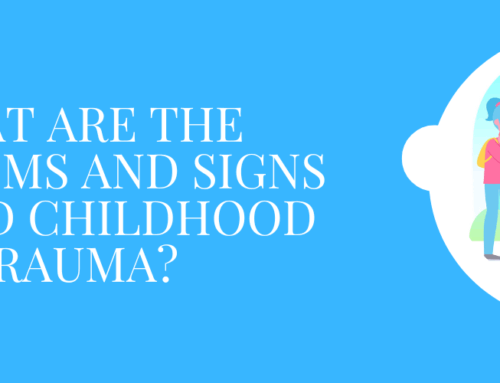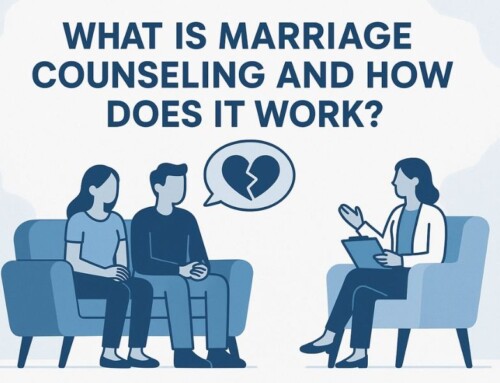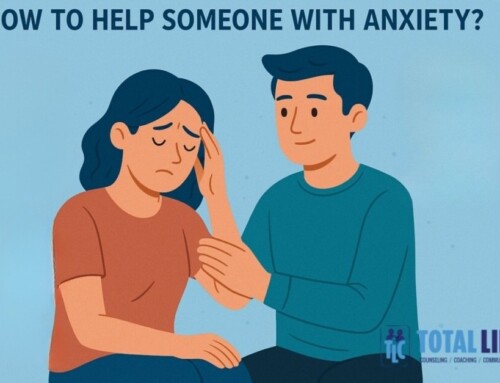Trauma vs PTSD: How They Affect Mental Health?
TL;DR
|
|---|
Trauma and PTSD are words we hear a lot, but do we stop to think about how they show up in real life? Understanding mental health services and mental health isn’t just helpful-it’s essential, especially when you’re trying to make sense of what you’re feeling.
Here’s something that might surprise you: While most adults in the U.S. have experienced at least one traumatic event in their lifetime, only about 6% go on to develop PTSD.
That gap? It’s important. It means not everyone processes Trauma the same way, and not everyone needs the same kind of care. What works for one person may not work for another—and that’s okay.
So if you’re feeling stuck, anxious, or not quite like yourself after something challenging, you’re not alone. Total Life Counseling is here to help you sort through it all—with support that’s personal, compassionate, and works.
What Does Trauma Mean?
Trauma is what happens when you go through something distressing—like a serious accident, abuse, or even a natural disaster—and your mind and body just don’t know how to handle it. It’s not just about feeling shaken up for a while; trauma can affect your day-to-day life.
Let’s break down what it’s really like to go through something traumatic—because it’s more than just a bad memory.
- It usually starts with something overwhelming that leaves you feeling helpless, scared, or in shock.
- Your mind reacts in all sorts of emotional ways—like feeling super anxious, sad all the time, easily irritated, or just emotionally numb.
- But it’s not just in your head. Your body can feel it too—maybe you’re always tired, have random aches and pains, or can’t sleep well.
- You might have a hard time concentrating, feel stuck in your thoughts, or keep reliving parts of what happened through flashbacks or intrusive memories.
- Emotionally, it can make you pull away from people, or react with sudden anger or panic—even if you don’t fully understand why.
All of this is your mind and body trying to protect you in their own way. But if it goes on too long or feels like it’s taking over your life, it’s worth paying attention to. Recognizing the signs is the first step toward feeling better—and healing is possible.
Understanding the difference between conditions like other specific trauma and stressor-related disorders vs PTSD can also help in finding the right kind of support and treatment, especially when exploring trauma vs PTSD.
What Are The Different Types of Trauma?
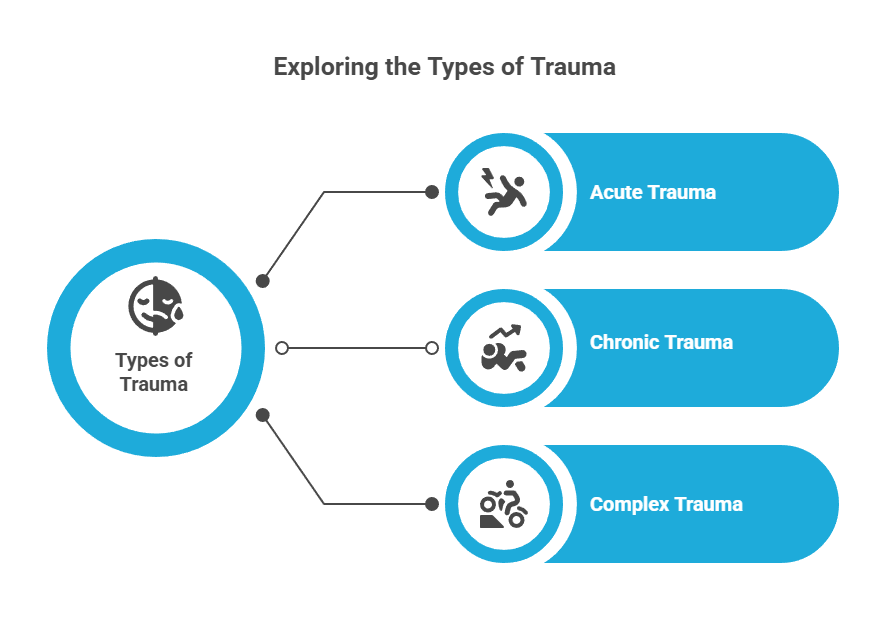
Trauma isn’t one-size-fits-all—it can show up in all kinds of ways depending on what someone’s been through. Let’s break down the main types in a simple, relatable way:
- Acute Trauma happens after a single, overwhelming event—like a car crash, a natural disaster, or an assault. Even if it only lasted a few moments, it can leave someone feeling shocked, scared, or frozen. The brain has a tough time making sense of what happened, which is why flashbacks or anxiety might pop up later.
- Chronic Trauma builds up slowly over time. It usually comes from ongoing stress—like being bullied, living in an abusive home, or dealing with long-term neglect. After a while, it starts to chip away at a person’s sense of safety. They might feel drained, emotionally shut down, or constantly on edge, like they can never fully relax.
- Complex Trauma is a deeper kind of hurt that comes from facing multiple traumatic experiences, especially in early life or close relationships—like childhood abuse, abandonment, or betrayal. It can affect everything from how someone sees themselves to how they connect with others. People might struggle with trust, feel unsafe even in calm situations, or struggle to identify themselves.
No matter what type it is, trauma—and everyone’s response to it is valid.
If you or someone you know is struggling, Total Life Counseling Tampa is here to help. Our compassionate therapists are trained to guide you through healing at your own pace. Reach out today and take that first step toward feeling better.
What is post-traumatic stress disorder (PTSD)?
PTSD is a mental health condition that can develop after you’ve experienced or witnessed something traumatic—like an accident, natural disaster, assault, or any life-threatening situation. It’s your mind and body’s way of saying, “That was too much,” and sometimes the stress keeps replaying long after the event is over.
In some cases, symptoms don’t fully meet the criteria for PTSD but still cause significant distress. This is where understanding Other Specified Trauma- and Stressor-Related Disorder vs PTSD becomes important, as both conditions require attention but may call for different treatment approaches.
Here’s a simple way to understand what PTSD can look like:
- Flashbacks and intrusive thoughts – You might feel like you’re reliving the event repeatedly, even if you’re safe now. These thoughts can pop up suddenly and feel incredibly real.
- Nightmares – Sleep can be tough when your brain keeps replaying what happened, leading to scary dreams or restless nights.
- Avoidance – You might find yourself staying away from certain places, people, or even conversations that remind you of what happened.
- Feeling numb or disconnected – It’s common to feel emotionally shut down or like you’re watching your life from the outside.
- Always on edge – PTSD can make you feel jumpy, irritable, or constantly alert, as if something bad is about to happen.
- Trouble concentrating or sleeping – Your mind may feel scattered, and restful sleep might be hard to come by.
PTSD isn’t just “in your head”—it’s a very real response to overwhelming stress. And while it can make everyday life feel tough, the good news is that help is available, and healing is possible.
What’s the Difference Between Trauma and PTSD?
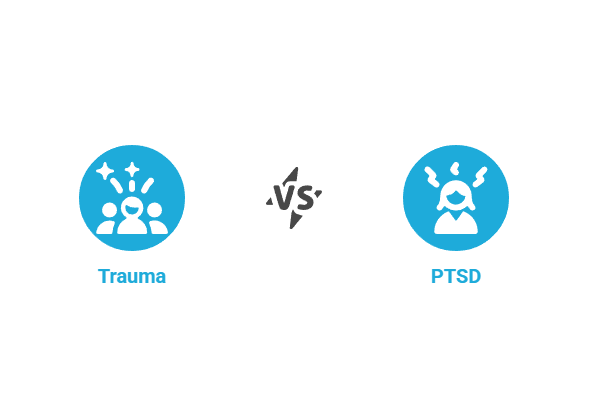
Understanding the difference between trauma and posttraumatic stress disorder (PTSD) is crucial when trying to make sense of your own experiences. Many people often wonder, “Is trauma and PTSD the same?” – but while they’re related, they’re not identical. It’s also helpful to explore related conditions – like Other Specified Trauma- and Stressor-Related Disorders– so you can find the support and treatment that best fits your needs.
The table below breaks down the key differences between trauma, PTSD, complex trauma vs PTSD, and related conditions to give you a clearer understanding.
|
Category |
Trauma |
PTSD (Post-Traumatic Stress Disorder) |
|---|---|---|
|
What it is |
An emotional and psychological response to a distressing event |
A mental health condition that can develop after experiencing or witnessing trauma |
|
Common Causes |
Car accidents, traumatic disasters, sudden loss |
Same as trauma, but especially when the brain tries to recover from the event |
|
Duration |
Often short-term, may fade with time, and support |
Long-lasting and persistent if untreated |
|
Symptoms |
Shock, fear, sadness, anxiety, emotional overwhelm |
Flashbacks, nightmares, emotional numbness, avoidance, hypervigilance |
|
Recovery |
Many people recover naturally with time, rest, and support |
Often requires professional help, such as therapy or medication |
|
Who it affects |
Anyone who has gone through a distressing experience |
A smaller group of trauma survivors who don’t recover naturally |
|
Key Difference |
It’s a response to something traumatic |
It’s a disorder that may develop after trauma and interfere with daily li |
|
Did it happen from others’ trauma? |
Not typically |
Yes — known as secondary PTSD or vicarious trauma, common in caregivers or trauma victims |
If anything in this table feels familiar, know that you’re not alone. TLC is here to help—whenever you’re ready, we’re prepared to support your healing.
How Can I Prevent Trauma From Turning Into PTSD?
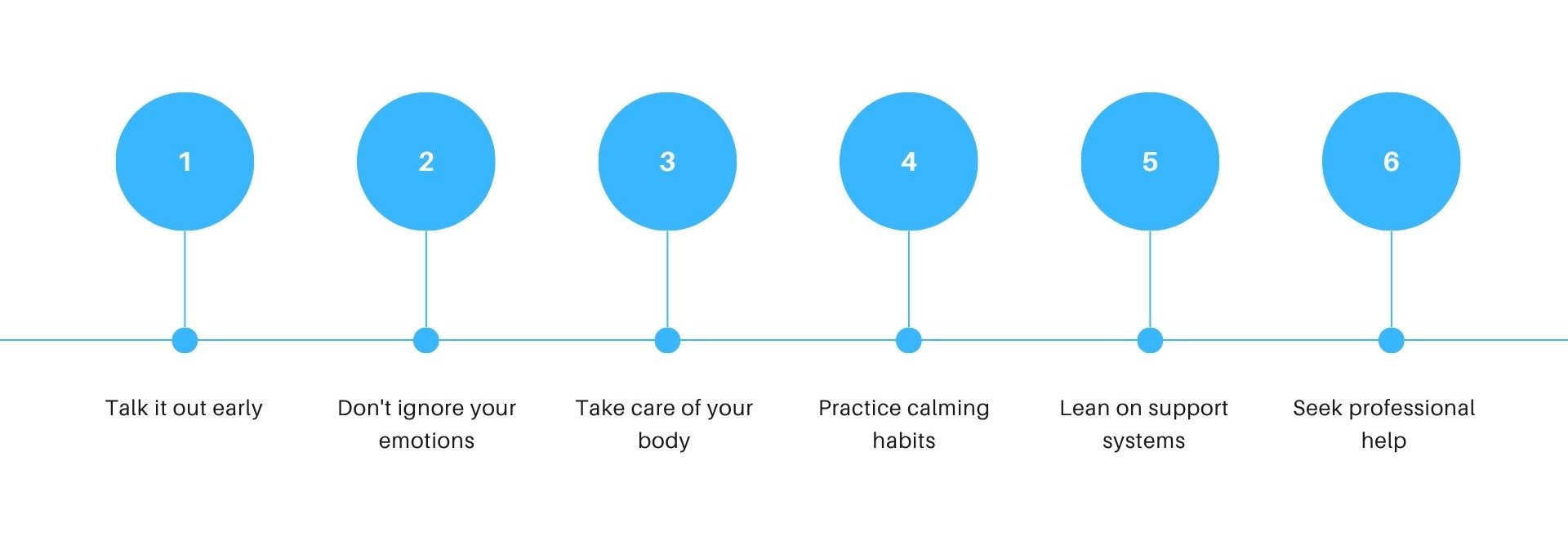
Going through something traumatic can leave you feeling overwhelmed, but that doesn’t mean it has to turn into PTSD. While trauma is a natural emotional response to distressing events, PTSD is a more serious mental health condition that may develop if that trauma isn’t processed or supported.
PTSD, look out for symptoms that last for an extended period of more than a month and start affecting your daily life—like flashbacks, nightmares, avoiding reminders of the event, or feeling constantly on edge. If those signs show up and don’t fade, it could be a sign that trauma is developing into PTSD.
Don’t ignore your emotions – Pushing feelings away might seem easier short-term, but allowing yourself to feel, cry, or even get angry is part of healing. Ignoring these feelings may lead some individuals to engage in negative coping mechanisms, including substance abuse.
- Talk it out early – Whether with friends or through family counseling, processing emotions is key.
- Don’t ignore your emotions – Pushing feelings away might seem easier short-term, but allowing yourself to feel, cry, or even get angry is part of healing.
- Take care of your body – Rest, eat well, and move a little each day. These basics do support emotional recovery.
- Practice calming habits – Mindfulness and grounding can help, or even play therapy for younger individuals.
- Lean on support systems – Being around people you trust reminds your brain you’re not alone and that you’re safe now.
- Seek professional help – Anxiety therapy can be beneficial if you’re feeling stuck or hyper-alert.
And if you’re wondering, can everyone who experiences trauma develop PTSD? The answer is no. Reactions to trauma, understanding when trauma becomes PTSD, can help in recognizing when support is needed.
What Are the Treatment Options for Trauma and PTSD?
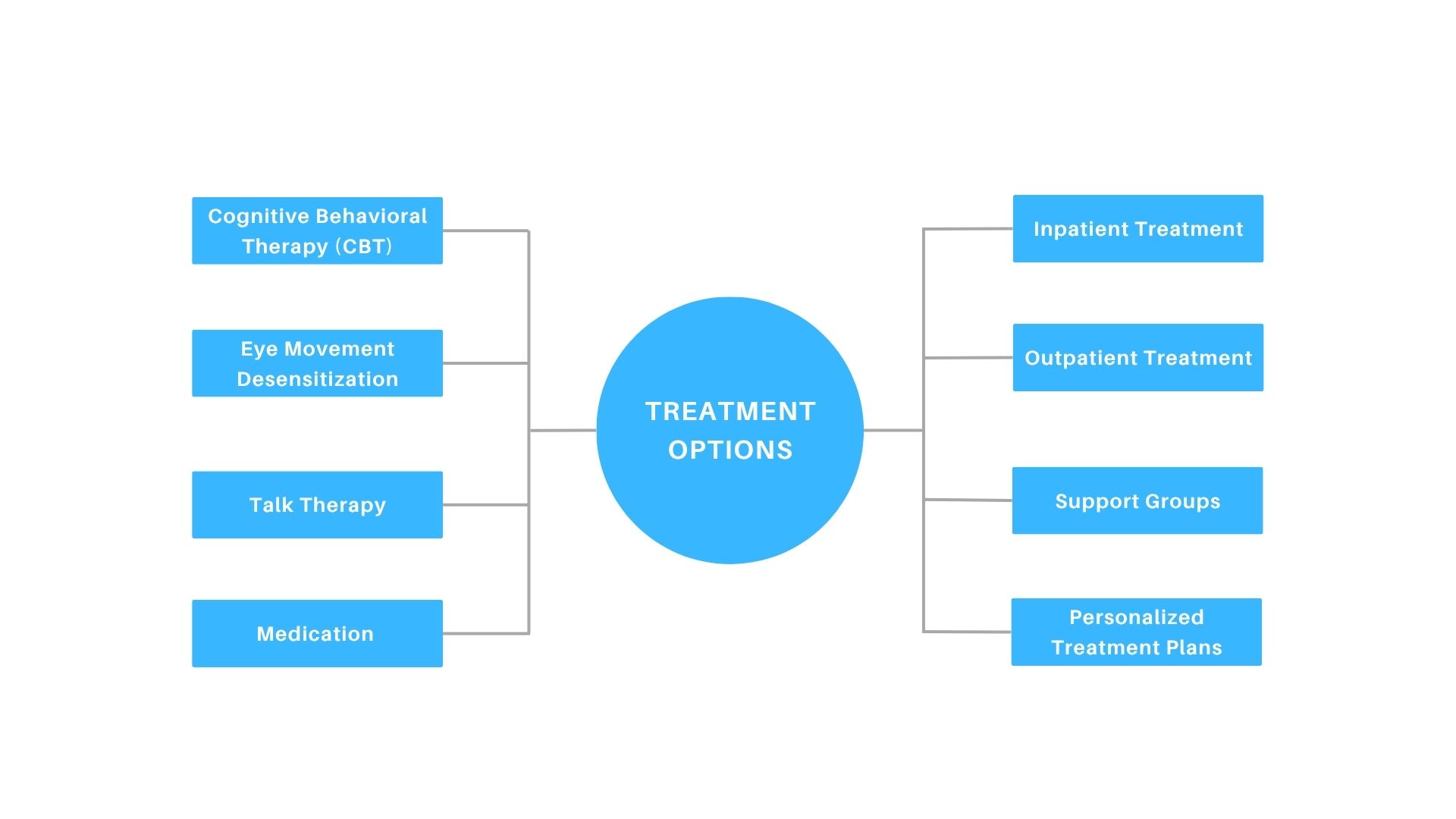
Recovering from trauma and PTSD doesn’t look the same for everyone. The good news is, there are several proven ways to feel better, take back control, and start healing at your own pace. Here’s a simple, no-pressure breakdown of the options available:
- Cognitive Behavioral Therapy (CBT): This psychotherapy helps you spot and shift those negative thought patterns that often come with trauma. It’s practical, focused, and effective at helping trauma regain emotional balance.
- Eye Movement Desensitization and Reprocessing (EMDR): It’s a powerful method where guided eye movements help your brain “unstick” painful memories, so they don’t feel so intense over time.
- Talk Therapy (One-on-One or Group): Offers support, including couples counseling, to navigate trauma, strengthen communication, and heal together.
- Medication (If Trauma): For some people, medication can make it easier to manage anxiety, sleep problems, or depression while going through therapy. It’s not for everyone, but it can be an effective treatment tool when used thoughtfully.
- Inpatient Treatment: If your symptoms feel overwhelming, inpatient care offers full-time support in a safe, structured environment. You’ll get daily therapy, professional care, and space to heal without life’s everyday pressures.
- Outpatient Treatment: Want to keep up with your routine while getting support? Outpatient care lets you attend regular therapy sessions without putting your life on pause. It’s flexible, effective, and works well for many.
- Support Groups: Sometimes just being with people who’ve been through similar stuff can be a significant relief. Support groups offer connection, understanding, and hope—all in a safe, supportive space.
- Personalized Treatment Plans: No two people experience trauma in the same way. That’s why having a plan that’s built for you—your symptoms, your pace, your goals—can make all the difference.
Find Support for Trauma & PTSD with Total Life Counseling Expert Care
Struggling to cope after a traumatic experience? Maybe you’re feeling overwhelmed, stuck in the past, or constantly on edge. Whether you’re facing trauma or symptoms of PTSD, Total Life Counseling is here to walk alongside you with understanding, compassion, and tools that truly help.
We offer personalized online therapy that fits into your life—no need to leave home. Guided by Gemima McMahon, MA, LMHC, our evidence-based approach supports healing and helps answer essential questions like offering clarity, tools, and emotional support.
Book your free 15-minute consultation today—because you deserve support that works, and healing that lasts.
Conclusion
Understanding the difference between trauma and PTSD is key to supporting mental health. While many people experience trauma, not everyone develops PTSD—and that can be reassuring. Trauma’s ability to recover often depends on support, coping strategies, and time.
When symptoms persist, treatments like CBT and EMDR can be incredibly helpful in processing painful experiences. Prioritizing mental health and seeking personalized care is an essential step toward healing. You don’t have to navigate it alone—help is available, and recovery is possible.
Frequently Asked Questions
How does childhood trauma differ from adult trauma in its impact?
Childhood trauma often results in more profound long-term effects, shaping personality and emotional regulation, including potential impacts from increased levels of cortisol (the stress hormone) on executive functions. In contrast, adult trauma may lead to immediate responses but can be processed with greater resilience. Both can significantly affect mental health, yet their developmental implications differ markedly.
What role does social support play in recovering from trauma and preventing PTSD?
Social support plays a vital role in helping individuals recover from trauma. Feeling connected to others can create a sense of safety and belonging, ease emotional distress, and reduce isolation. Supportive relationships also promote healthy coping strategies, which can lower the risk of developing PTSD.
How can someone help a loved one who is dealing with trauma or PTSD?
Supporting a loved one dealing with trauma or PTSD involves trauma-informed listening without judgment, validating their feelings, and encouraging professional help. Be patient, maintain open communication, and offer to accompany them to therapy or support groups. Your presence can make a significant difference in their healing journey.
Share This Story, Choose Your Platform!
Total Life Counseling Center consists of Licensed Counselors, masters level therapists, Español counselors, Licensed Mental Health Counselors, business coaches, and image enhancement coaches who provide counseling for emotional, mental, physical and spiritual care including marriage, individual, family, substance abuse and more. TLC’s family, trauma and marriage experts have been interviewed on National and Local TV/Radio over 200 times for their expert advice on Fox News, OWN, WETV, ABC’s Medical Minute and more. Our skilled counselors are relational, approachable and specialists providing therapy services in the Central Florida area including: Orlando, Winter Park, MetroWest, Windermere, Dr. Phillips, East Orlando, Lake Mary, and Clermont, Boca Raton Florida, and Dallas, TX.

